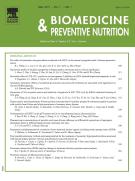Fucoxanthin, a marine carotenoid protects cadmium-induced oxidative renal dysfunction in rats - 14/08/13

Abstract |
Cadmium (Cd) is a non-essential transition metal widely distributed in the environment as a pollutant and has been shown to induce health hazards by having carcinogenic, mutagenic, teratogenic and cytotoxic effects. Exposure of human populations to cadmium from air, food and water may produce toxic effects in organs such as the kidneys, liver, lungs, cardiovascular, immune and reproductive systems. Since Cd has been identified as a human carcinogen, biomarkers for early detection of susceptibility to cancer are of an importance to public health. The ability to document Cd exposure and uptake of this element through biological monitoring is a first step towards understanding its health effects. The present study has been designed to investigate the protective role of fucoxanthin (Fxn), on cadmium chloride-induced oxidative stress and renal dysfunction in rats by analyzing the biochemical key enzymes and histopathological studies. The results revealed that administration of cadmium chloride significantly induced the renal dysfunction which was evident from the increased levels of serum blood urea nitrogen, creatinine, lipid peroxidation and concurrently the antioxidants enzymes levels of superoxide dismutase, glutathione peroxidase, reduced glutathione was significantly decreased. Interestingly, on administration of fucoxanthin along with cadmium chloride-intoxicated rats were found a significant decrease in the levels of blood urea nitrogen, creatinine, lipid peroxidation and an increase in the levels of renal antioxidant enzymes which inevitably confirms that Fxn has a prominent role in preventing the renal damage during treatment. Further histopathological examination revealed that cadmium-induced renal tissue damage was reduced by Fxn treatment. Our results suggest that Fxn reduces the cadmium-induced oxidative renal dysfunction in rats.
Le texte complet de cet article est disponible en PDF.Keywords : Fucoxanthin, Cadmium chloride, Renal dysfunction, Oxidative stress
Plan
Vol 3 - N° 3
P. 201-207 - juillet 2013 Retour au numéroBienvenue sur EM-consulte, la référence des professionnels de santé.
L’accès au texte intégral de cet article nécessite un abonnement.
Déjà abonné à cette revue ?

